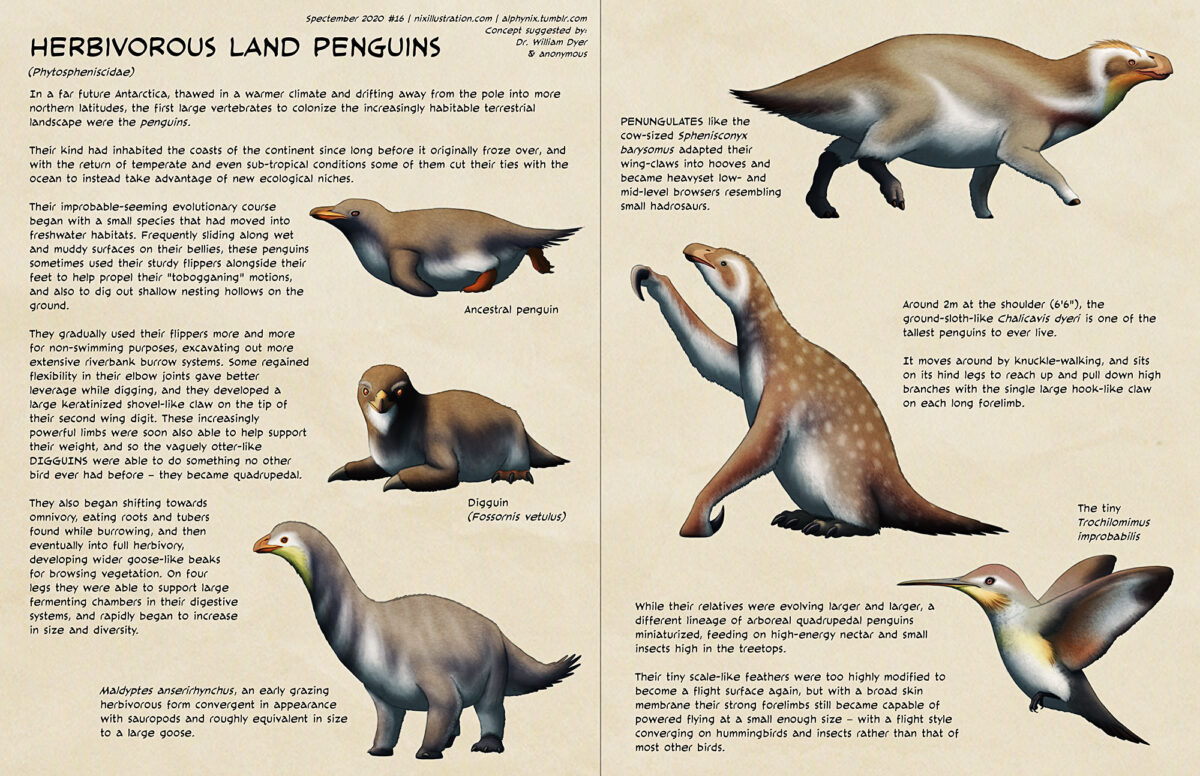(also flying ones because why not)
Transcript for the text on the image under the cut:
PAGE 1
Spectember 2020 #16 | nixillustration.com | alphynix.tumblr.com
Concept suggested by:
Dr. William Dyer
& anonymous
Herbivorous Land Penguins
(Phytospheniscidae)
In a far future Antarctica, thawed in a warmer climate and drifting away from the pole into more northern latitudes, the first large vertebrates to colonize the increasingly habitable terrestrial landscape were the penguins.
Their kind had inhabited the coasts of the continent since long before it originally froze over, and with the return of temperate and even sub-tropical conditions some of them cut their ties with the ocean to instead take advantage of empty ecological niches.
Their improbable-seeming evolutionary course began with a small species that had moved into freshwater habitats. Frequently sliding along wet and muddy surfaces on their bellies, these penguins sometimes used their sturdy flippers alongside their feet to help propel their “tobogganing” motions, and also to dig out shallow nesting hollows on the ground.
[Image: a small penguin sliding on its belly]
Ancestral penguin
They gradually used their flippers more and more for non-swimming purposes, excavating out more extensive riverbank burrow systems. Some regained flexibility in their elbow joints gave better leverage while digging, and they developed a large keratinized shovel-like claw on the tip of their second wing digit. These increasingly powerful limbs were soon also able to help support their weight, and so the vaguely otter-like DIGGUINS were able to do something no other bird ever had before – they became quadrupedal.
They also began shifting towards omnivory, eating roots and tubers found while burrowing, and then eventually into full herbivory, developing wider goose-like beaks for browsing vegetation. On four legs they were able to support large fermenting chambers in their digestive systems, and they rapidly began to increase in size and diversity.
[Image: a descendant of the small penguin laying on the ground. It’s a chunky bird with a body shape vaguely like a wombat, and it has a large shovel-like claw on the tip of each of its flippers.]
Digguin (Fossornis vetulus)
[Image: a sauropod-like quadrupedal penguin with a goose-like head and neck, a chunky body, and four short legs.]
Maldyptes anserirhynchus, an early grazing herbivorous form convergent in appearance with sauropods and roughly equivalent in size to a large goose.
PAGE 2
[Image: a hadrosaur-like quadrupedal penguin with an especially fat body and hoof-like claws.]
PENUNGULATES like the cow-sized Sphenisconyx barysomus adapted their wing-claws into hooves and became heavyset low- and mid-level browsers resembling small hadrosaurs.
[Image: a penguin that resembles a ground sloth or chalicothere, with huge hook-like claws on its long knuckle-walking arms.]
Around 2m at the shoulder (6’6″), the ground-sloth-like Chalicavis dyeri is one of the tallest penguins to ever live.
It moves around by knuckle-walking, and sits on its hind legs to reach up and pull down high branches with the single large hook-like claw on each long forelimb.
[Image: a tiny and ridiculously improbable hummingbird-like flying penguin.]
The tiny Trochilomimus improbabilis
While their relatives were evolving larger and larger, a different lineage of arboreal quadrupedal penguins miniaturized, feeding on high-energy nectar and small insects high in the treetops.
Their tiny scale-like feathers were too highly modified to become a flight surface again, but with a broad skin membrane their strong forelimbs still became capable of powered flying at a small enough size – with a flight style converging on hummingbirds and insects rather than that of most other birds.

